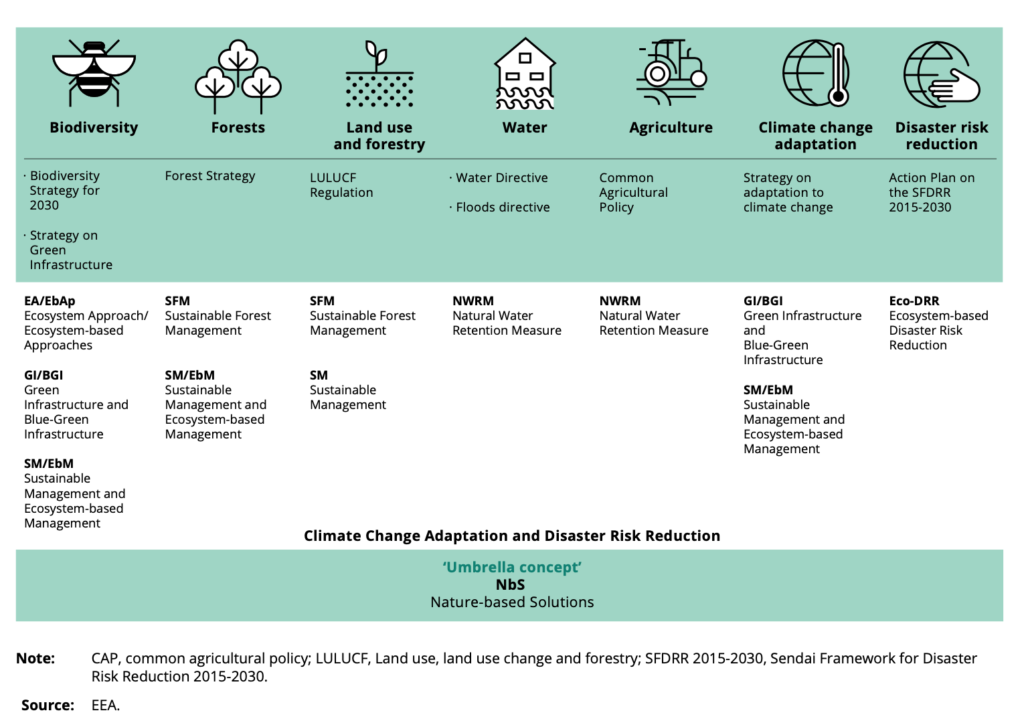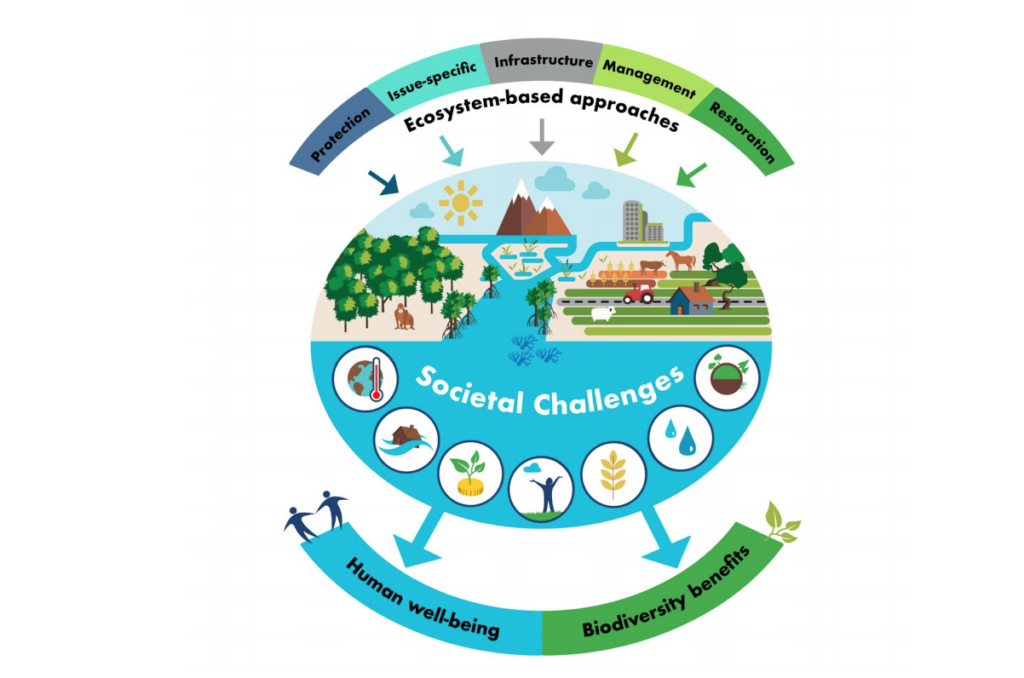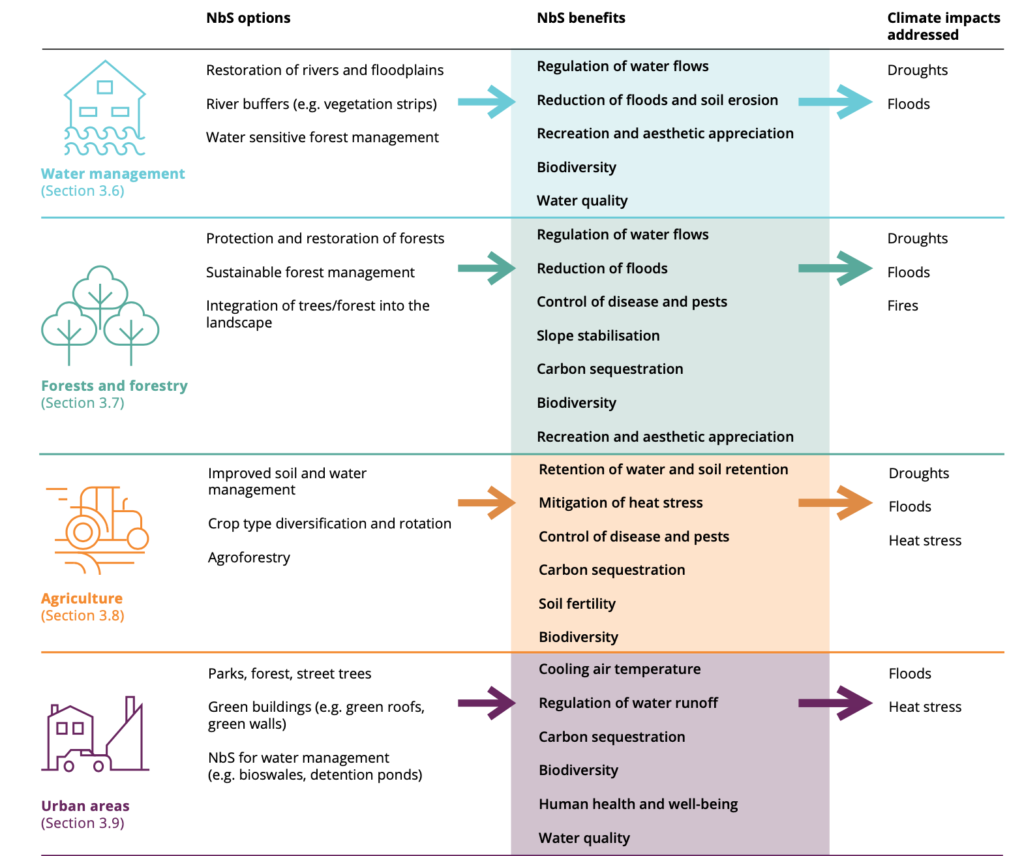Over the last decade, Nature-based Solutions (NbS) has become an increasingly popular “umbrella term”, raising the profile of nature as a tool with which to solve a variety of climate-related problems. In a nutshell, the appeal of NbS derives from their multifunctionality: they provide a multitude of environmental, social and economic benefits intertwining disaster risk reduction, climate change mitigation and adaptation with biodiversity and ecosystem restoration and protection.
Although NbS is not a novel concept – with other parallel terms such as Ecosystem-based approaches having been around for decades – since the turn of the century policymakers have started to hone in on their potential for providing environmental, social and economic benefits whilst helping to build resilience against climate change-induced risks.
Nature-based solutions are solutions provided by nature to the challenges we face as humans.
Cecil Konijnendijk
“Making nature healthy again is key to our physical and mental wellbeing and is an ally in the fight against climate change and disease outbreaks. It is at the heart of our growth strategy, the European Green Deal, and is part of a European recovery that gives more back to the planet than it takes away,” states Ursula von der Leyen, President of the European Commission, in her comments on the EU’s biodiversity strategy for 2030.
Implicit in the move towards NbS by policymakers is a recognition of the interdependent nature of climate change and ecosystem degradation and biodiversity loss. A double-edged sword whereby degraded ecosystems are both caused by and exacerbate climate change – which is already the third-largest global driver of biodiversity loss.
So what exactly are NbS? Their rapid rise in popularity with governments, businesses and civil society has gone hand in hand with increased efforts to define what exactly the term encompasses and how to establish the principles and guidelines with which to evaluate their performance.
Working towards a clear definition of NbS will not only help their deployment but is also important to shed new light on just how wide-ranging these solutions can be and ensuring that the term isn’t misappropriated whilst helping stakeholders assess the effectiveness of said solutions.
What are Nature-based Solutions?
The NbS concept emerged in the early 2000s as a nature centred response to climate change-related issues. In its initial development, it was strongly supported by the International Union for Conservation of Nature and later by the European Commission who both recognized the need to create an umbrella term that would encompass a variety of nature centred approaches.

As such NbS encompasses other terms including ecosystem-based approaches, ecosystem-based adaptation, ecosystem-based disaster risk reduction, green infrastructure/blue-green infrastructure and sustainable management/ecosystem-based management/sustainable forest management.
Today, the IUCN Global Standard provides a clear definition of NbS and a common framework to help benchmark progress. This is fundamental to increase the scale and impact of NbS, prevent unanticipated negative outcomes or misuse, and help funding agencies, policy makers and other stakeholders assess the effectiveness of interventions.

NbS are rooted in the ecosystem approach: namely that ecosystems produce a diverse range of services on which human well-being depends, from storing carbon, controlling floods and stabilising shorelines and slopes to providing clean air and water, food, fuel, medicines and genetic resources. In this regard, people can not only benefit from nature but they can also proactively protect, manage or restore natural ecosystems as a purposeful and significant contribution to addressing major societal challenges, explains Sergio Castellari, climate change adaptation expert at the European Environment Agency (EEA) until March 2021, currently working at the National Institute of Geophysics and Volcanology (INGV) and first co-lead author of the Nature-based solutions in Europe: Policy, knowledge and practice for climate change adaptation and disaster risk reduction report (EEA Report) published on 15 April 2021.
“By introducing a broader category like NbS you are saying: ecosystem-based approaches are not useful just in specific sectors such as adaptation, disaster risk reduction (DRR), and water management but they are key to tackling bigger societal challenges and contributing to our wider wellbeing. An umbrella concept like NbS usefully emphasises the importance of multi-functionality (i.e. providing multiple environmental, economic and social benefits at the same time) within sectoral interventions and policies,” explains CMCC researcher in the Risk Assessment and Adaptation Strategies division and co-author of the EEA Report, Elisa Calliari.
Nature-based Solutions are actions to protect, sustainably manage, and restore natural and modified ecosystems that address societal challenges effectively and adaptively, simultaneously providing human well-being and biodiversity benefits.
INTERNATIONAL UNION FOR CONSERVATION OF NATURE (IUCN)
“NbS is good to have as a concept because it is easily understood across disciplines, sectors, and policy domains. Everybody understands that we face major challenges, for example in our cities, and that nature can help us deal with some of these (e.g. climate change, public health challenges),” explains Cecil Konijnendijk, Professor of Urban Forestry at the University of British Columbia, and director of the Nature Based Solutions Institute.
“The benchmark for the success of an NbS is whether it allows a community or the wider society to reach its needs and aspirations,” continues Calliari.
Multifunctionality at the core of NbS
As climate change and biodiversity loss continue to threaten human society NbS are a recognition of the possibility of working with nature to reduce these threats and a central part of effective and efficient climate change adaptation (CCA) and disaster risk reduction (DRR) approaches. Furthermore, NbS can bring additional social, environmental and economic benefits compared to other solutions. But how can these additional benefits be quantified?
“Assessment methods such as iTree use the comparison between urban forest solutions and technical solutions (e.g., filters, air conditioning, drainage pipes) to assess the benefit and monetary value of the former,” explains Koninjndeijk, who also outlines that quantifying the benefits of NbS compared to other solutions is still very much a work in progress.
Due to the fact that NbS are designed to reduce social and environmental vulnerabilities, whilst carrying a variety of co-benefits such as mitigating climate change, improving human health and well-being, and providing jobs and business opportunities, “Being able to assess their multifunctionality is key, as many times they can prove to be ‘preferable’ to grey or hybrid alternatives when all their additional social, environmental and economic benefits are highlighted,” explains Calliari.

“I think that the strength of this definition lies in its emphasis on multifunctionality, i.e. the fact that NBS can provide multiple environmental, social and economic benefits at the same time. This means that we should not only care about protecting and managing ecosystems because it is important from an ’environmental point of view’, but because it is really key to support our well-being as a society,” she continues.
Ensuring that the definition of NbS and all its complexities is covered is one of the objectives of the EEA Report which provides and up to date and complete definition of NbS – including a wide range of case studies and examples of how NbS and related concepts are increasingly used in both global and EU policy frameworks.
“In Europe, we are still missing agreed consistent standards of methodologies and adequate metrics for performance evaluation for NbS,” explains Castellari, who believes “NbS need to upscale and pass from the local scale where they are implemented and become interconnected. For this to happen NbS has to be integrated into the EU climate law with legally binding biodiversity and adaptation targets. If this happens we will finally have regulatory support to start using a more intelligent, systemic and fast approach to NbS.”
The EEA Report also highlights the ample opportunities for mainstreaming nature-based solutions into diverse sectors across Europe (i.e. making them part of everyday practice), which can support the transformative change needed to address the interdependent climate and biodiversity challenges.
“We need to standardise assessment and valuation approaches where we can and integrate them in general economic and other assessments systems,” explains Konjindeijk.
Nature-based Solutions and policy
As policymakers across the globe grow familiar with NbS and their potential there has been a rise in investments in nature so that it can contribute to the health and well-being of people and the planet.
The European Commission defines NbS as responses to societal challenges that are inspired and supported by nature, which are cost-effective, simultaneously provide environmental, social and economic benefits and help build resilience.

Effective methods must therefore boost biodiversity and support the delivery of a range of ecosystem services, playing a key role in addressing both the climate and the biodiversity crises while accelerating transformative societal change.
Globally speaking the Parties to the Convention on Biological Diversity at COP 14 also recognizes the potential of NbS and has adopted voluntary guidelines for ecosystem-based approaches to climate change adaptation and disaster risk reduction.
Furthermore, Nature-Based Solutions are also considered an essential component of the overall global effort to achieve the goals of the Paris Agreement on Climate Change. “On a practical level these two global schemes – namely the UNFCCC and the Convention on Biological Diversity (CBD) – must reach the same meeting point: preserve and restore nature and use it in a sustainable manner to fight climate change,” explains Castellari.
“The biodiversity and climate change issues are twin crises that have to be faced together. Preserving biodiversity is a fundamental part of tackling climate change and vice-versa,” he continues.
Although the terms referring to NbS used in international and European policy circles do vary, the common denominator is that using nature-based strategies has the potential to strengthen the resilience of ecosystems, protect biodiversity and reduce the risk of extreme weather and climate-related disasters whilst tackling broader societal challenges, by providing multiple benefits, e.g. climate change mitigation, human health and well-being, and working towards the sustainable development goals.
At the global and EU level, the 2030 agenda for sustainable development and the European Green Deal include a variety of NbS. The European Green Deal includes initiatives such as the new EU biodiversity strategy for 2030 which has nature restoration plans among its objectives. These kinds of measures have the potential to boost the adoption and implementation of NbS.
Nature-based Solutions in practice
Urban greening approaches are some of the NbS that have received the most media attention over the last few years. “The NbS term has really raised the profile of strategies such as urban green spaces on political agendas at different levels,” explains Konijnendijk.
It is widely recognised that urban areas offer great potential to contribute to the protection of species and habitats as well as climate change adaptation and disaster risk reduction through the implementation of biodiverse NbS (e.g. urban allotments and gardens, green parks, pollinator sites, green corridors, wetland restoration, sustainable urban drainage systems or green walls and roofs) to bring more and more diverse nature into cities, outlines the EEA Report.
The biodiversity and climate change issues are twin crises that have to be faced together. Preserving biodiversity is a fundamental part of tackling climate change and vice-versa.
SERGIO CASTELLARI
“When I advise national and local governments, for example when they want to develop urban forestry strategies, a lot of focus is on the benefits these urban forests are providing. This obviously links to NbS as well and the term has started to ‘creep into’ strategies and plans,” says Konijnendijk
Another recent NbS that has gained a lot of attention is the farm-to-fork strategy, a key component of the European Green Deal which aims to “make food systems fair, healthy and environmentally friendly”.
These are just two examples of how NbS are explicitly recognised for their ability to help deliver better climate and environmental results whilst increasing climate resilience.
What lies ahead
Policies have begun to reflect the growing recognition that, while ecosystems and their services are vulnerable to climate change, they can also serve to protect society from climate change impacts. These climate and biodiversity crises are interdependent, as they share multiple drivers.
“Society is at a strategic point in time at which nature-based solutions and related concepts can play a key role in addressing the combined climate and biodiversity crises while contributing to accelerating transformative change,” says Castellari.
Although appropriate indicators, evaluation tools and integrated assessment methods are needed to allow better evaluation of the net effect of nature-based solutions, the growing recognition of their potential and the acceptance of an umbrella term such as NbS can help bring together strategies for biodiversity and ecosystem restoration with those aimed at tackling climate change.






